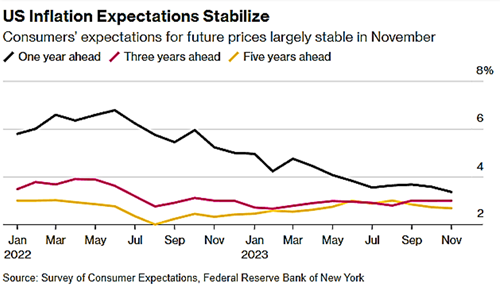The Driver Of Returns – Installment II (Dec. 15, 2023)
Overview
This installment aims to suggest likely paths for all-important interest rates. Per our prior installment,
“Beyond the cashflow or earnings performance of an individual firm, the next driver for nearly all investments are prevailing interest rates. However, not all investors seriously consider where rates are going and what is driving them.”
Good Call
Since our recent installment, the WSJ shared our view that interest rate cuts are likely in 2024:
“Most officials penciled in three interest rate cuts for 2024 in projections released after their two-day meeting on Wednesday.”¹
Furthermore, the chances of a hard landing appear to be dissipating: “Yellen Says U.S. Economy on Path to Soft Landing”²
Hence, recent private debt investments and similar investments are likely to be viewed as part of a “Goldilocks era” (i.e., not too hot not too cold, but just right) for attractive risk-adjusted returns.
Figure I: Stabilization of Consumer Price Expectations for the Future

Post-2024
Now for the hard part, which is how to reconcile the massive deficits and sovereign debt for most Western nations. To address this issue, a bit of history is probably helpful. The sovereignty controls the terms or “contract” upon which the currency is based. The “contract” has changed over time.
The Continentals
First used during the American Revolution, the term “not as good as a continental” referred to the fact that the American currency lost value as the skimpy Colonial treasury reserves were depleted due to war expenses.³ To provide comfort, subsequent currencies were backed by gold reserves and were freely convertible into gold.
FDR
However, in response to the strains of the Great Depression, FDR changed the contract and prohibited the Treasury and financial institutions from redeeming dollars for gold for citizens and businesses.⁴
Nixon
In more recent times, President Nixon was faced with a deterioration in balance of payments as military spending simultaneously placed pressure on the dollar, which was pegged to gold at $35 per ounce. In response, Nixon removed the dollar’s peg to gold to prevent a run on the dollar. President Nixon’s Treasury secretary John Connelly acknowledged there was a change in the “contract,” stating, “the dollar is our currency, but it’s your problem.”⁵
Current Times
Per our prior installment, Mr. Gundlach suggests that 5 years from now, 50% of tax receipts will be needed to pay Federal interest expense, which is obviously not sustainable. The question is: what are some possible outcomes and how will they manifest in interest rates? Our view is that due to Mr. Paulson’s and Mr. Bernanke’s efforts to fight the credit crisis of 2008, the Fed (and other central banks) has been given extraordinary powers.⁶ For example, economic textbooks written prior to 2009 are largely silent on negative interest since, to the traditional economist, it makes little sense. However, due to quantitative easing, interest rate suppression has been the norm.
Turning to deal with massive deficits and massive sovereign debt, we expect the central banks will again employ extraordinary measures.
Our View
Our view is that the central banks will come to the rescue and purchase debt issued by Western countries’ treasuries. There is no reason the central banks cannot double or triple their holdings. One might question the soundness of such actions, and such questions are entirely reasonable. However, our view is that such concerns will take a back seat to the more pressing concerns of keeping the government operating.
Yes, there would be a concern of repeat of the Weimar Republic (with a runaway printing of currency), but such concerns can be ameliorated via a more measured creation of currency. In fact, as we saw post the 2008 Credit Crisis, the purchases by the central bank depressed interest rates as they purchased the bulk of the bonds issued.
Caveat: Too Much of a Good Thing
Our preference is that governments be run on a sound basis without any changes in the “contract” associated with currency. However, such personal views are subordinate to our attempts to provide best judgements on what is likely to happen. Over time, investors adjust to explicit or implicit changes in the currency and investment rate “contracts.”
Central banks are certainly powerful, but not omnipotent. Lastly, watch for a normalization of the yield curve.
Sources
[1] https://www.wsj.com/economy/central-banking/fed-holds-rates-steady-and-…
[2] https://www.wsj.com/economy/central-banking/yellen-says-u-s-economy-…
[3] https://www.investopedia.com/terms/c/continentals.asp
[4] https://www.federalreservehistory.org/essays/gold-reserve-act
[5] https://www.ipe.com/the-dollar-is-our-currency-but-its-your-problem/25599.article
[6] https://www.wsj.com/articles/sun-shines-on-new-york-fed-doomsday-book-…
Get in Touch
Contact our team to arrange a meeting and receive further information.

